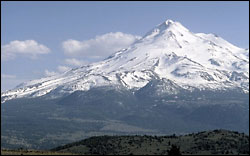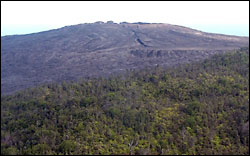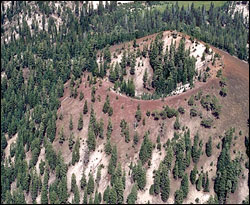 |
|||||||||||||||||||||||||||||||||||||
|
Volcanoes
In-Depth How do volcanoes create rock? About 500 million people live close to active
volcanoes! Many of them do not even realize it. What are the different types of volcanoes?
1) Composite Volcanoes. Sometimes called stratovolcanoes, some of Earth's grandest volcanoes are composite. These steep-sided mountains stand as high as 8,000 feet. They're built of layers of lava, ash, cinders, and other materials that rise from deep in the earth's crust during an eruption. Composite volcanoes usually have circular depressions at their summits. Depressions of less than a mile across are called craters; larger depressions are calderas. Examples: Mount Fuji in Japan, Mount Cotopaxi in Ecuador, Mount Shasta
in California, Mount St. Helens and Mount Rainier in Washington
2) Shield Volcanoes. Resembling an upturned warrior's shield, these volcanoes have long gentle slopes. They build up slowly from numerous eruptions of basaltic lava that spreads widely over great distances. Examples: Kilauea and Mauna Loa on the island of Hawaii
3) Cinder Cones. The simplest type of volcano, these are created by an accumulation of cinders and other volcanic debris that erupt from a single vent. The material falls back to the earth around the vent in a circular or oval cone. Most cinder cones have a bowl-shaped crater at the summit and rarely rise more than a thousand feet or so above their surroundings. Examples: Lava Butte Cinder Cone, Oregon The rock debris carried by a lateral blast of Mount
St. Helens traveled as fast as 250 miles per hour. |
||||||||||||||||||||||||||||||||||||



